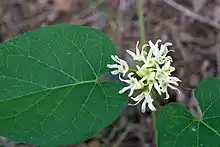Matelea baldwyniana
Matelea baldwyniana is a species of climbing or trailing vine with white flowers in the family Apocynaceae (dogbane), known by the common name Baldwin's milkvine[3] and white spinypod.[4] It previously belonged to the family Asclepiadaceae (milkweed). It is native to the central and southeastern United States.
| Matelea baldwyniana | |
|---|---|
 | |
| Scientific classification | |
| Kingdom: | Plantae |
| Clade: | Tracheophytes |
| Clade: | Angiosperms |
| Clade: | Eudicots |
| Clade: | Asterids |
| Order: | Gentianales |
| Family: | Apocynaceae |
| Genus: | Matelea |
| Species: | M. baldwyniana |
| Binomial name | |
| Matelea baldwyniana (Sweet) Woodson | |
| Synonyms[2] | |
|
List
| |
Description
M. baldwyniana is a perennial herbaceous vine that climbs or trails on other vegetation, reaching a height of about 3 m (10 ft). The stems are brownish, hairy, and have a milky sap. The leaves are green, broadly ovate, and opposite, with smooth margins. The leaves are 5–16 cm (2–6 in) long on hairy petioles that are 5–6 cm (2–2 in) long.[5]
The flowers, borne in clusters of 15 or more on long peduncles, are white with a disc-like central column with five anthers and five twisting white petals that are joined at the base. Seed pods are 6.5–9 cm (2.6–3.5 in) long and contain flat, round seeds with many long, white hairs, similar to other milkweeds.[6]
Etymology
The specific epithet honors American botanist William Baldwin (1779 - 1819).[7]
Distribution and habitat
Matelea baldwyniana is native to the central and southeastern United States in the states of Oklahoma, Arkansas, Missouri, Mississippi, Alabama, Georgia, and Florida.[8] The plant is mostly present in Arkansas and Missouri, with only isolated populations or historical references in the other states.[1] Its habitat is forest clearings, woods, slopes of ravines,[4] glades, and savannas.[5]
Ecology
Flowering occurs April to June. M. baldwyniana is a host plant for caterpillars of the monarch butterfly.[6]
References
- "NatureServe Explorer 2.0". explorer.natureserve.org.
- "Matelea baldwyniana (Sweet) Woodson | Plants of the World Online | Kew Science". Plants of the World Online.
- "USDA Plants Database". plants.usda.gov.
- "Matelea baldwyniana - Species Page - APA: Alabama Plant Atlas". floraofalabama.org.
- "Matelea baldwyniana page". www.missouriplants.com.
- "Know Your Natives – Baldwin's Climbing Milkweed and Anglepod Milkvine". Arkansas Native Plant Society. 26 October 2014.
- "Baldwyn's Milkvine". www.fs.usda.gov.
- "2013 BONAP North American Plant Atlas. TaxonMaps". bonap.net.
